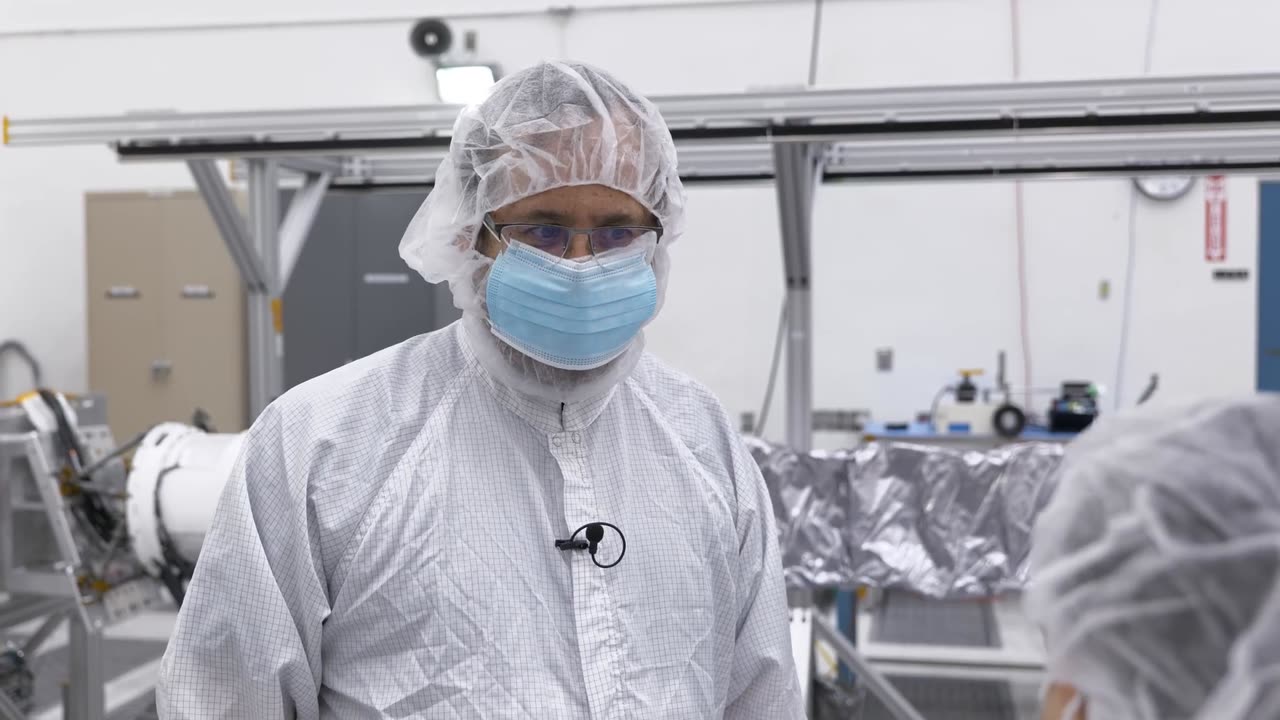Premium Only Content

Spacecraft Makers: Testing Europa Clipper’s Magnetometer
#spacecraft #spacecraftmakers #testingeuropaclippers #europaclippers #magnetometer #nasa #nasaspacemission #nasa2030 #spacecraft2030 #jetpropulsion #launch #jupiter #jupiterexploration #jupiterjourney #spaceexploration #wc1 #wolfchamp
Spacecraft Makers: Testing Europa Clipper’s Magnetometer
Join team members from NASA’s Europa Clipper mission in a clean room at NASA’s Jet Propulsion Laboratory to learn about testing of the spacecraft’s magnetometer, which will help scientists answer the question, “Does Europa have an ocean?”
The magnetometer is made up of a long, 28-foot (6.5-meter) boom and three fluxgate sensors, which are compressed in a canister on the side of the spacecraft until the boom is deployed after launch. The electronics for the instrument are contained in the vault of the spacecraft, along with electronics for the other science instruments.
Spacecraft Makers is a video series that takes audiences behind the scenes to learn more about how space missions, like Europa Clipper, come together. Europa Clipper will explore this icy moon of Jupiter to see if there are conditions suitable for life. Scientists have evidence that a global ocean lies under the moon’s surface, and the mission aims to confirm the existence of the ocean.
The spacecraft needs to be hardy enough to survive a 1.6-billion-mile, six-year journey to Jupiter – and sophisticated enough to perform a detailed science investigation of Europa once it arrives at the Jupiter system in 2030.
Europa Clipper is expected to launch in October 2024 from Kennedy Space Center in Florida.
Spacecraft Makers: Testing Europa Clipper’s Magnetometer
Join team members from NASA’s Europa Clipper mission in a clean room at NASA’s Jet Propulsion Laboratory to learn about testing of the spacecraft’s magnetometer, which will help scientists answer the question, “Does Europa have an ocean?”
The magnetometer is made up of a long, 28-foot (6.5-meter) boom and three fluxgate sensors, which are compressed in a canister on the side of the spacecraft until the boom is deployed after launch. The electronics for the instrument are contained in the vault of the spacecraft, along with electronics for the other science instruments.
Spacecraft Makers is a video series that takes audiences behind the scenes to learn more about how space missions, like Europa Clipper, come together. Europa Clipper will explore this icy moon of Jupiter to see if there are conditions suitable for life. Scientists have evidence that a global ocean lies under the moon’s surface, and the mission aims to confirm the existence of the ocean.
The spacecraft needs to be hardy enough to survive a 1.6-billion-mile, six-year journey to Jupiter – and sophisticated enough to perform a detailed science investigation of Europa once it arrives at the Jupiter system in 2030.
Europa Clipper is expected to launch in October 2024 from Kennedy Space Center in Florida.
Spacecraft Makers: Testing Europa Clipper’s Magnetometer
Join team members from NASA’s Europa Clipper mission in a clean room at NASA’s Jet Propulsion Laboratory to learn about testing of the spacecraft’s magnetometer, which will help scientists answer the question, “Does Europa have an ocean?”
The magnetometer is made up of a long, 28-foot (6.5-meter) boom and three fluxgate sensors, which are compressed in a canister on the side of the spacecraft until the boom is deployed after launch. The electronics for the instrument are contained in the vault of the spacecraft, along with electronics for the other science instruments.
Spacecraft Makers is a video series that takes audiences behind the scenes to learn more about how space missions, like Europa Clipper, come together. Europa Clipper will explore this icy moon of Jupiter to see if there are conditions suitable for life. Scientists have evidence that a global ocean lies under the moon’s surface, and the mission aims to confirm the existence of the ocean.
The spacecraft needs to be hardy enough to survive a 1.6-billion-mile, six-year journey to Jupiter – and sophisticated enough to perform a detailed science investigation of Europa once it arrives at the Jupiter system in 2030.
Europa Clipper is expected to launch in October 2024 from Kennedy Space Center in Florida.
Spacecraft Makers: Testing Europa Clipper’s Magnetometer
Join team members from NASA’s Europa Clipper mission in a clean room at NASA’s Jet Propulsion Laboratory to learn about testing of the spacecraft’s magnetometer, which will help scientists answer the question, “Does Europa have an ocean?”
The magnetometer is made up of a long, 28-foot (6.5-meter) boom and three fluxgate sensors, which are compressed in a canister on the side of the spacecraft until the boom is deployed after launch. The electronics for the instrument are contained in the vault of the spacecraft, along with electronics for the other science instruments.
Spacecraft Makers is a video series that takes audiences behind the scenes to learn more about how space missions, like Europa Clipper, come together. Europa Clipper will explore this icy moon of Jupiter to see if there are conditions suitable for life. Scientists have evidence that a global ocean lies under the moon’s surface, and the mission aims to confirm the existence of the ocean.
The spacecraft needs to be hardy enough to survive a 1.6-billion-mile, six-year journey to Jupiter – and sophisticated enough to perform a detailed science investigation of Europa once it arrives at the Jupiter system in 2030.
Europa Clipper is expected to launch in October 2024 from Kennedy Space Center in Florida.
Spacecraft Makers: Testing Europa Clipper’s Magnetometer
Join team members from NASA’s Europa Clipper mission in a clean room at NASA’s Jet Propulsion Laboratory to learn about testing of the spacecraft’s magnetometer, which will help scientists answer the question, “Does Europa have an ocean?”
The magnetometer is made up of a long, 28-foot (6.5-meter) boom and three fluxgate sensors, which are compressed in a canister on the side of the spacecraft until the boom is deployed after launch. The electronics for the instrument are contained in the vault of the spacecraft, along with electronics for the other science instruments.
Spacecraft Makers is a video series that takes audiences behind the scenes to learn more about how space missions, like Europa Clipper, come together. Europa Clipper will explore this icy moon of Jupiter to see if there are conditions suitable for life. Scientists have evidence that a global ocean lies under the moon’s surface, and the mission aims to confirm the existence of the ocean.
The spacecraft needs to be hardy enough to survive a 1.6-billion-mile, six-year journey to Jupiter – and sophisticated enough to perform a detailed science investigation of Europa once it arrives at the Jupiter system in 2030.
Europa Clipper is expected to launch in October 2024 from Kennedy Space Center in Florida.
-
 LIVE
LIVE
Kim Iversen
2 hours agoTim Pool Tried To HUMILIATE Me. Now What? | Erika Kirk Conspiracies PROVEN and Debunked
1,733 watching -
 2:26:34
2:26:34
Redacted News
2 hours ago"We must prepare for war with Russia!" NATO and Europe preparing for all out war | Redacted
100K28 -
 4:43
4:43
WallStreetBets
2 hours ago $1.12 earnedWallStreetBets is now on Rumble
6.29K11 -
 1:14:54
1:14:54
vivafrei
3 hours agoWhite Guilt, or White Supremacy? FBI Ping of Brian Cole Explained! Trans Madness & MORE!
116K37 -
 1:34:37
1:34:37
The Quartering
5 hours agoTyler Robinson Court Appearance, Gross Thinfluencers Destroying Women, AI Backlash & Deportations
130K39 -
 1:53:05
1:53:05
Darkhorse Podcast
5 hours agoScience: The Rebel Reboot | The 304th Evolutionary Lens with Bret Weinstein and Heather Heying
33.9K21 -
 LIVE
LIVE
LFA TV
21 hours agoLIVE & BREAKING NEWS! | THURSDAY 12/11/25
958 watching -
 LIVE
LIVE
freecastle
7 hours agoTAKE UP YOUR CROSS- In all these things WE ARE MORE than conquerors through HIM who loved us!
84 watching -
 2:09:50
2:09:50
MattMorseTV
6 hours ago $45.07 earned🔴Trump's MASSIVE Morning UPDATE.🔴
70.6K147 -
 1:12:52
1:12:52
iCkEdMeL
4 hours ago $6.21 earnedTyler Robinson in Court TODAY — Media Fight & Gag Order Battle
38.2K14